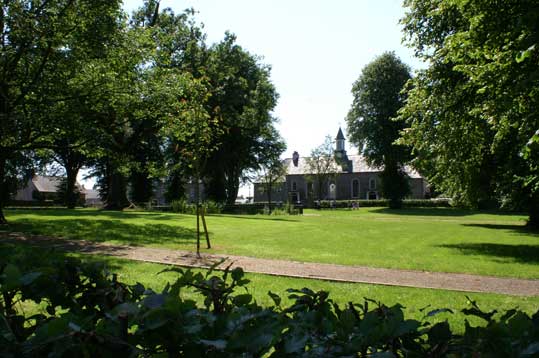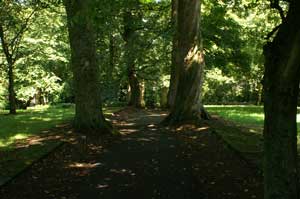By Rob Christie
The Moravian village of Gracehill, near Ballymena, Co. Antrim, was established in the 1760s, based on the teachings of two Czech theologians and philosophers, John Huss (1372–1450) and John Comenius (1592–1670). Comenius is considered to be the father of modern education. The Moravians were one of the earliest groups to break with the Catholic Church. Persecution of the sect resulted in 1720 in their flight to Saxony, where they were given protection by Count Nikolaus Zinzendorf, who founded the Moravian settlement at Herrnhut.
In England, dissatisfaction with conventional religious practices resulted in the formation of several small Moravian groups or ‘Societies’, with a great emphasis placed on undertaking missionary work. John Cennick, who introduced the Moravian faith to Ireland, was originally a follower of the Wesley brothers. He met Zinzendorf in 1743 and embraced the teachings of the Moravians. In 1746 he preached in Dublin and Ballymena with Benjamin La Trobe, one of the English leaders.
By 1747 Moravian societies in Ireland had over 500 members but many more attended services. In County Antrim four different societies were combined into a central congregation at Gloonan. This was a temporary site, and in 1763 they leased and subsequently purchased 363 acres from Lord O’Neill in the Ballykennedy townland, naming the new settlement Gracehill. The village was built around a central square with the church at its head and stands today much as it was two and a half centuries ago. To the rear of the church lies ‘God’s Acre’, a peaceful and beautiful area, the final resting-place of residents of Gracehill.
FIVE CHARACTERISTICS
The Moravian Church, formally the ‘Unitas Fratrum’ or ‘Unity of Brethren’, is one of the oldest Protestant denominations. The Moravian bishop C.H. Shawe wrote in 1977 that the church had five characteristics: simplicity, which leads to the following of the teachings of the Bible; happiness, a response to God’s gift of salvation; unobtrusiveness, the acceptance of different churches for different spiritual needs; fellowship, a gathering together of all people in the society as equals; and the ideal of service, the extension of God’s teaching by missionary work. Between 1732 and 1832, 1,199 missionaries were sent to the West Indies, Greenland, Africa and Lapland. Later missions were set up in America, Alaska and Australia.
The church was renowned for its educational programmes, which prioritised the education of girls at a time when the education of women was considered unnecessary. In 1765 a day-school for girls was opened, followed by a school for boys in 1770. The success of the quality of education delivered in Gracehill resulted in wealthy families from outside the community paying to have their children educated there. A Ladies’ Academy was established in 1797 and a Boys’ Academy in 1805, which catered for boarders.
SEPARATION OF MEN AND WOMEN
A distinguishing feature of Moravian society, practised in Gracehill, was the separation of men and women, boys and girls, in their everyday activities. The Brethren, as they were called, were divided according to age into ‘choirs’ comprising small children, older children, single men and women, and then married men and women. Each group focused on different aspects of Jesus’s life; leadership came from within the groups, and it was believed that the separation allowed both sexes to focus their attention without distraction on God. Women played an integral role in the church, leading their own ‘choirs’, unlike other religious institutions which even today restrict the leadership role of women.
This separation continued in death—the gravestones of women are found on the right of the central pathway and those of the men to the left in order of their passing. God’s Acre is accessible either by the sisters’ or brothers’ walk, and children are buried to the rear of the adults. The stones are laid almost flat, indicating equality, and have only a basic inscription, which includes the name, date of death and sometimes a birth date.
METICULOUS RECORDS
The Gracehill Moravians kept meticulous records dating back to the commencement of the settlement. Registers of births, deaths and marriages as well as daily diaries give a comprehensive picture of life in the community from the mid-1700s to the present. Several years ago, the Gracehill church warden began the daunting task of transcribing the recorded burials and creating a plan to show their location in the graveyard. This huge task was completed in 2019 and there is now a complete plan of burial sites and several books listing those interred in alphabetical and burial order. Over 260 years many of the stones have become weather-worn and undecipherable, while others are difficult to read because of a covering of moss. As the years passed, it was obvious that the identities of those recorded on the stones could be lost forever.

In 2017 the task of cleaning and photographing each stone was commenced. This was an enormous undertaking, which has taken several years to complete. Using the new plan and books compiled from the registers, the names on many of the stones have been identified despite having only a few readable letters or numbers.
PRACTICAL PROBLEMS
There have been other problems which have made it difficult to match the photographs with the warden’s work. An early gardener found that maintaining the area was difficult with the stones spread out, so he moved both the early men’s and women’s stones into abutting lines along the central pathway—no consideration was given to the graves that were not marked by a stone.
Numerous stones did not align with the names in the registers, some sites had no markers, other stones did not appear in the written records and many were broken. Despite these difficulties, most of the stones have been identified and compiled into two colour folios. Each volume contains a photo of the stone, its number, grid position and the details recorded on it; if no stone is present, the appropriate entry from the register has been included. A digital copy will allow researchers to look up a name in the index, and a series of clicks will direct them to the site of the grave and then to a photo of the stone, if it exists. Copies of these are held at the church in Gracehill and by the North of Ireland Family History Society, which has made a financial contribution to the production of the records.

Gracehill is the only Moravian community that remains as an independent entity in Ireland. In 1975 Gracehill was designated Northern Ireland’s first conservation area, recognising its unique character. The village square is beautifully maintained and surrounded by the original buildings, although they are no longer owned by the community. The church holds well-attended weekly services, currently conducted by Revd Sarah Groves, a bishop in the Moravian Church. The local school, although run by the State, closely observes the Moravian principles of education. Although life in the village is very different from that of the eighteenth century, the layout and distinctive Georgian architecture remain, and the Moravian church around which life revolved is still the central feature of the village and the gathering place for the Brethren.
Rob Christie is a retired school principal who has written a number of books on the Gippsland Goldfields in Victoria, Australia.
Further reading
R.W. Christie, ‘The Moravian village of Gracehill, Northern Ireland: the La Trobes and an Australian connection’, in Latrobeana: Journal of the C.J. La Trobe Society 20 (3) (2021), 34–43.
J.E. Hutton, A history of the Moravian Church (Trim, 2017).
C.H. Shawe, The spirit of the Moravian Church (London, 1977).
